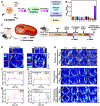Advanced targeted nanomedicines for vulnerable atherosclerosis plaque imaging and their potential clinical implications
- PMID: 36313319
- PMCID: PMC9606597
- DOI: 10.3389/fphar.2022.906512
Advanced targeted nanomedicines for vulnerable atherosclerosis plaque imaging and their potential clinical implications
Abstract
Atherosclerosis plaques caused by cerebrovascular and coronary artery disease have been the leading cause of death and morbidity worldwide. Precise assessment of the degree of atherosclerotic plaque is critical for predicting the risk of atherosclerosis plaques and monitoring postinterventional outcomes. However, traditional imaging techniques to predict cardiocerebrovascular events mainly depend on quantifying the percentage reduction in luminal diameter, which would immensely underestimate non-stenotic high-risk plaque. Identifying the degree of atherosclerosis plaques still remains highly limited. vNanomedicine-based imaging techniques present unique advantages over conventional techniques due to the superior properties intrinsic to nanoscope, which possess enormous potential for characterization and detection of the features of atherosclerosis plaque vulnerability. Here, we review recent advancements in the development of targeted nanomedicine-based approaches and their applications to atherosclerosis plaque imaging and risk stratification. Finally, the challenges and opportunities regarding the future development and clinical translation of the targeted nanomedicine in related fields are discussed.
Keywords: atherosclerosis; atherosclerosis molecular imaging; imaging biomarkers; targeted nanoparticle-based contrast agents; vulnerable plaques.
Copyright © 2022 Li, Wu, Li, Guo, Zhao and Zhang.
Conflict of interest statement
The authors declare that the research was conducted in the absence of any commercial or financial relationships that could be construed as a potential conflict of interest.
Figures














Similar articles
-
Coronary Atherosclerosis Imaging.Diagnostics (Basel). 2020 Jan 24;10(2):65. doi: 10.3390/diagnostics10020065. Diagnostics (Basel). 2020. PMID: 31991633 Free PMC article. Review.
-
Targeting the Microenvironment of Vulnerable Atherosclerotic Plaques: An Emerging Diagnosis and Therapy Strategy for Atherosclerosis.Adv Mater. 2022 Jul;34(29):e2110660. doi: 10.1002/adma.202110660. Epub 2022 May 29. Adv Mater. 2022. PMID: 35238081 Review.
-
Advances of nanoparticle-mediated diagnostic and theranostic strategies for atherosclerosis.Front Bioeng Biotechnol. 2023 Nov 9;11:1268428. doi: 10.3389/fbioe.2023.1268428. eCollection 2023. Front Bioeng Biotechnol. 2023. PMID: 38026849 Free PMC article. Review.
-
Current Toolset in Predicting Acute Coronary Thrombotic Events: The "Vulnerable Plaque" in a "Vulnerable Patient" Concept.Life (Basel). 2023 Mar 4;13(3):696. doi: 10.3390/life13030696. Life (Basel). 2023. PMID: 36983851 Free PMC article. Review.
-
Vulnerable Atherosclerotic Plaque: Is There a Molecular Signature?Int J Mol Sci. 2022 Nov 7;23(21):13638. doi: 10.3390/ijms232113638. Int J Mol Sci. 2022. PMID: 36362423 Free PMC article. Review.
Cited by
-
Detection of atherosclerotic plaques with HDL-like porphyrin nanoparticles using an intravascular dual-modality optical coherence tomography and fluorescence system.Sci Rep. 2024 May 29;14(1):12359. doi: 10.1038/s41598-024-63132-6. Sci Rep. 2024. PMID: 38811670 Free PMC article.
-
Macrophage-based pathogenesis and theranostics of vulnerable plaques.Theranostics. 2025 Jan 2;15(4):1570-1588. doi: 10.7150/thno.105256. eCollection 2025. Theranostics. 2025. PMID: 39816684 Free PMC article. Review.
-
Cardiovascular Tissue Engineering Models for Atherosclerosis Treatment Development.Bioengineering (Basel). 2023 Nov 29;10(12):1373. doi: 10.3390/bioengineering10121373. Bioengineering (Basel). 2023. PMID: 38135964 Free PMC article. Review.
-
Dual Source Photon-Counting Computed Tomography-Part II: Clinical Overview of Neurovascular Applications.J Clin Med. 2023 May 23;12(11):3626. doi: 10.3390/jcm12113626. J Clin Med. 2023. PMID: 37297821 Free PMC article. Review.
-
A comprehensive review on nanoparticle-based photo acoustic: current application and future prospective.Discov Nano. 2024 Dec 24;19(1):214. doi: 10.1186/s11671-024-04173-8. Discov Nano. 2024. PMID: 39718756 Free PMC article. Review.
References
-
- Aboyans V., Ricco J. B., Bartelink M. E. L., Björck M., Brodmann M., Cohnert T., et al. (2018). 2017 ESC guidelines on the diagnosis and treatment of peripheral arterial diseases, in collaboration with the European society for vascular surgery (ESVS): Document covering atherosclerotic disease of extracranial carotid and vertebral, mesenteric, renal, upper and lower extremity arteriesEndorsed by: The European stroke organization (ESO) the task force for the diagnosis and treatment of peripheral arterial diseases of the European society of Cardiology (ESC) and of the European society for vascular surgery (ESVS). Eur. Heart J. 39 (9), 763–816. 10.1093/eurheartj/ehx095 PubMed Abstract | 10.1093/eurheartj/ehx095 | Google Scholar - DOI - DOI - PubMed
-
- Aizaz M., Moonen R. P. M., van der Pol J. A. J., Prieto C., Botnar R. M., Kooi M. E. (2020). PET/MRI of atherosclerosis. Cardiovasc. Diagn. Ther. 10 (4), 1120–1139. 10.21037/cdt.2020.02.09 PubMed Abstract | 10.21037/cdt.2020.02.09 | Google Scholar - DOI - DOI - PMC - PubMed
-
- Akyuz A. (2020). Exercise and coronary heart disease. Adv. Exp. Med. Biol. 1228, 169–179. 10.1007/978-981-15-1792-1_11 PubMed Abstract | 10.1007/978-981-15-1792-1_11 | Google Scholar - DOI - DOI - PubMed
-
- Allahverdian S., Chehroudi A. C., Mcmanus B. M., Abraham T., Francis G. A. (2014). Contribution of intimal smooth muscle cells to cholesterol accumulation and macrophage−like cells in human atherosclerosis. Circulation 129, 1551–1559. 10.1161/CIRCULATIONAHA.113.005015 PubMed Abstract | 10.1161/CIRCULATIONAHA.113.005015 | Google Scholar - DOI - DOI - PubMed
-
- Alphandéry E. (2022). Nanomaterials as ultrasound theragnostic tools for heart disease treatment/diagnosis. Int. J. Mol. Sci. 23 (3), 1683. 10.3390/ijms23031683 PubMed Abstract | 10.3390/ijms23031683 | Google Scholar - DOI - DOI - PMC - PubMed
Publication types
LinkOut - more resources
Full Text Sources

